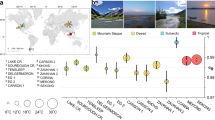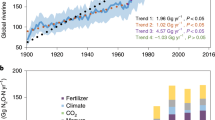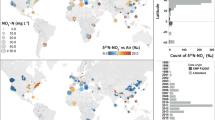Abstract
Anthropogenic addition of bioavailable nitrogen to the biosphere is increasing1,2 and terrestrial ecosystems are becoming increasingly nitrogen-saturated3, causing more bioavailable nitrogen to enter groundwater and surface waters4,5,6. Large-scale nitrogen budgets show that an average of about 20–25 per cent of the nitrogen added to the biosphere is exported from rivers to the ocean or inland basins7,8, indicating that substantial sinks for nitrogen must exist in the landscape9. Streams and rivers may themselves be important sinks for bioavailable nitrogen owing to their hydrological connections with terrestrial systems, high rates of biological activity, and streambed sediment environments that favour microbial denitrification6,10,11. Here we present data from nitrogen stable isotope tracer experiments across 72 streams and 8 regions representing several biomes. We show that total biotic uptake and denitrification of nitrate increase with stream nitrate concentration, but that the efficiency of biotic uptake and denitrification declines as concentration increases, reducing the proportion of in-stream nitrate that is removed from transport. Our data suggest that the total uptake of nitrate is related to ecosystem photosynthesis and that denitrification is related to ecosystem respiration. In addition, we use a stream network model to demonstrate that excess nitrate in streams elicits a disproportionate increase in the fraction of nitrate that is exported to receiving waters and reduces the relative role of small versus large streams as nitrate sinks.
This is a preview of subscription content, access via your institution
Access options
Subscribe to this journal
Receive 51 print issues and online access
$199.00 per year
only $3.90 per issue
Buy this article
- Purchase on Springer Link
- Instant access to full article PDF
Prices may be subject to local taxes which are calculated during checkout




Similar content being viewed by others
References
Vitousek, P. M. et al. Human alteration of the global nitrogen cycle: Sources and consequences. Ecol. Appl. 7, 737–750 (1997)
Galloway, J. N. et al. Nitrogen cycles past, present, and future. Biogeochemistry 70, 153–226 (2004)
Aber, J. D. et al. Nitrogen saturation in temperate forest ecosystems. Bioscience 48, 921–934 (1998)
Bouwman, A. F., Van Drecht, G., Knoop, J. M., Beusen, A. H. W. & Meinardi, C. R. Exploring changes in river nitrogen export to the world’s oceans. Glob. Biogeochem. Cycles 19 GB1002 10.1029/2004GB002314 (2005)
Johnes, P. J. & Butterfield, D. Landscape, regional and global estimates of nitrogen flux from land to sea: Errors and uncertainties. Biogeochemistry 57, 429–476 (2002)
Schlesinger, W. H., Reckhow, K. H. & Bernhardt, E. S. Global change: The nitrogen cycle and rivers. Water Resource Res. 42 W03S06 10.1029/2005WR004300 (2006)
Howarth, R. W. et al. Riverine inputs of nitrogen to the North Atlantic Ocean: fluxes and human influences. Biogeochemistry 35, 75–139 (1996)
Boyer, E. W. et al. Riverine nitrogen export from the continents to the coasts. Glob. Biogeochem. Cycles 20 GB1S91 10.1029/2005GB002537 (2006)
Van Breemen, N. et al. Where did all the nitrogen go? Fate of nitrogen inputs to large watersheds in the northeastern USA. Biogeochemistry 57, 267–293 (2002)
Seitzinger, S. P. et al. Denitrification across landscapes and waterscapes: a synthesis. Ecol. Appl. 16, 2064–2090 (2006)
Hedin, L. O. et al. Thermodynamic constraints on nitrogen transformations and other biogeochemical processes at soil–stream interfaces. Ecology 79, 684–703 (1998)
Stream Solute Workshop. Concepts and methods for assessing solute dynamics in stream ecosystems. J. N. Am. Benthol. Soc. 9, 95–119 (1990)
Dodds, W. K. et al. N uptake as a function of concentration in streams. J. N. Am. Benthol. Soc. 21, 206–220 (2002)
O’Brien, J. M., Dodds, W. K., Wilson, K. C., Murdock, J. N. & Eichmiller, J. The saturation of N cycling in Central Plains streams: 15N experiments across a broad gradient of nitrate concentrations. Biogeochemistry 10.1007/s10533–007–9073–7 (2007)
Hall, R. O. & Tank, J. L. Ecosystem metabolism controls nitrogen uptake in streams in Grand Teton National Park, Wyoming. Limnol. Oceanogr. 48, 1120–1128 (2003)
Mulholland, P. J. et al. Effects of light on NO3- uptake in small forested streams: diurnal and day-to-day variations. J. N. Am. Benthol. Soc. 25, 583–595 (2006)
Christensen, P. B., Nielsen, L. P., Sørensen, J. & Revsbech, N. P. Denitrification in nitrate-rich streams: Diurnal and seasonal variation related to benthic oxygen metabolism. Limnol. Oceanogr. 35, 640–651 (1990)
Piña-Ochoa, E. & Alvarez-Cobelas, M. Denitrification in aquatic environments: A cross-system analysis. Biogeochemistry 81, 111–130 (2006)
Alexander, R. B., Smith, R. A. & Schwarz, G. E. Effect of stream channel size on the delivery of nitrogen to the Gulf of Mexico. Nature 403, 758–761 (2000)
Peterson, B. J. et al. Control of nitrogen export from watersheds by headwater streams. Science 292, 86–90 (2001)
Seitzinger, S. P. et al. Nitrogen retention in rivers: Model development and application to watersheds in the northeastern USA. Biogeochemistry 57, 199–237 (2002)
Wollheim, W. M., Vörösmarty, C. J., Peterson, B. J., Seitzinger, S. P. & Hopkinson, C. S. Relationship between river size and nutrient removal. Geophys. Res. Lett. 33, L06410 (2006)
McIsaac, G., David, M. B., Gertner, G. Z. & Goolsby, D. A. Nitrate flux in the Mississippi River. Nature 414, 166–167 (2001)
Hill, J., Nelson, E., Tilman, D., Polasky, S. & Tiffany, D. Environmental, economic, and energetic costs and benefits of biodiesel and ethanol biofuels. Proc. Natl Acad. Sci. USA 103, 11206–11210 (2006)
Tilman, D., Cassman, K. G., Matson, P. A., Naylor, R. & Polasky, S. Agricultural sustainability and intensive production practices. Nature 418, 671–677 (2002)
Foley, J. A. et al. Global consequences of land use. Science 309, 570–574 (2005)
Beman, J. M., Arrigo, K. R. & Matson, P. A. Agricultural runoff fuels large phytoplankton blooms in vulnerable areas of the ocean. Nature 434, 211–214 (2005)
Newbold, J. D., Elwood, J. W., O’Neill, R. V. & Van Winkle, W. Measuring nutrient spiraling in streams. Can. J. Fish. Aquat. Sci. 38, 860–863 (1981)
Webster, J. W. & Valett, H. M. in Methods in Stream Ecology (eds Hauer, F. R. & Lamberti, G. A.) 169–186 (Elsevier, New York, 2006)
Mulholland, P. J. et al. Stream denitrification and total nitrate uptake rates measured using a field 15N isotope tracer approach. Limnol. Oceanogr. 49, 809–820 (2004)
Sigman, D. M. et al. Natural abundance-level measurement of the nitrogen isotopic composition of oceanic nitrate: an adaptation of the ammonia diffusion method. Mar. Chem. 57, 227–242 (1997)
Hamilton, S. K. & Ostrom, N. E. Measurement of the stable isotope ratio of dissolved N2 in 15N tracer experiments. Limnol. Oceanogr. Methods 5, 233–240 (2007)
Acknowledgements
Funding for this research was provided by the National Science Foundation. We thank N. Ostrom for assistance with stable isotope measurements of N2 and N2O, and W. Wollheim for initial development of the model that we modified to estimate denitrification rates from field data. We thank M. Mitchell, B. Roberts and E. Bernhardt for their comments on earlier versions of the paper. We thank the NSF LTER network, US Forest Service, National Park Service and many private landowners for permission to conduct experiments on their lands. Partial support to P.J.M. during manuscript preparation was provided by the US Department of Energy, Office of Science, Biological and Environmental Research under contract with UT-Battelle.
Author Contributions P.J.M. coordinated the stream 15N experiments and analysed the compiled experimental data sets. A.M.H. and G.C.P conducted the stream network modelling. P.J.M., A.M.H. and G.C.P. wrote major portions of the manuscript. S.K.H. established sampling protocols and coordinated the 15N analysis of dissolved N2 samples. Except for A.M.H., all authors listed to J.R.W. were joint project Principal Investigators and contributed to the conceptual and methodological development of the project and analysis of data. Authors listed from C.P.A. to S.M.T. coordinated field experiments and analysed data from one or more biomes. All authors discussed the results and commented on the manuscript.
Author information
Authors and Affiliations
Corresponding author
Supplementary information
Supplementary Information
This file contains Supplementary Methods and Supplementary Discussion with additional references; Supplementary Figures and Legends 1-3; and Supplementary Tables 1-3. The Supplementary Methods include more detailed 15N experiment methods and stream network model development. The Supplementary Discussion presents NO3- removal over a standardized stream reach, effects of land use and stream size on uptake rates, and limitations of the data and stream network modeling results. The Supplemental Figure 1 shows study site locations, Figure 2 shows the stream network model structure, and Figure 3 shows the location and hydrography of the Little Tennessee River network used in model simulations. The Supplementary Table 1 presents physical and chemical characteristics and NO3- uptake and denitrification rates determined for all streams in the 15N experiments, Table 2 includes definitions of model terms, and Table 3 presents the methods used to derive model parameters. (PDF 535 kb)
Rights and permissions
About this article
Cite this article
Mulholland, P., Helton, A., Poole, G. et al. Stream denitrification across biomes and its response to anthropogenic nitrate loading. Nature 452, 202–205 (2008). https://doi.org/10.1038/nature06686
Received:
Accepted:
Issue Date:
DOI: https://doi.org/10.1038/nature06686
This article is cited by
-
Climate and landform interact to control the source and transport of nitrate in Pacific Northwest rivers
Communications Earth & Environment (2024)
-
Disentangling effects of multiple agricultural stressors on benthic and hyporheic nitrate uptake
Biogeochemistry (2024)
-
Wastewater-influenced estuaries are characterized by disproportionately high nitrous oxide emissions but overestimated IPCC emission factor
Communications Earth & Environment (2023)
-
Net-spinning caddisflies create denitrifier-enriched niches in the stream microbiome
ISME Communications (2023)
-
Temperature affects the ratio of ethylene produced to N2-fixed more than immediate release of fixed N in streams
Biogeochemistry (2023)
Comments
By submitting a comment you agree to abide by our Terms and Community Guidelines. If you find something abusive or that does not comply with our terms or guidelines please flag it as inappropriate.



